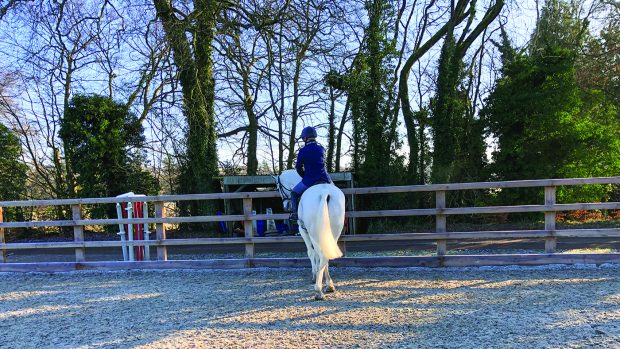Advertising feature
A closer take-off point and a cafeteria-style diet — that is the key advice that Sian Barton received for her ex-racehorse during the last of her Saracen Horse Feeds/H&H ex-racehorse to event horse 2016 bursary training sessions.
Sian, who completed her first CIC* on Kama Night this season, had a lesson with international showjumper Philip Spivey.
Find out what advice he has for showjumping ex-racehorses in the following video:
1. Keep your head up
“Ground pole exercises got the horse more supple and helped with straightness,” says Philip. “We also worked on Sian’s position. When she drops her head, it leads to her upper body collapsing. As soon as we straightened that out the horse jumped a lot better.”
2. Stay off the forehand
“At first the horse was a little on the forehand, so we worked at getting his hocks underneath him. Then Sian had to keep him up, not just with her hands but using her leg and seat. Then the horse was balanced around the corners rather than falling through his shoulder, so he could make a nice shape over fences.”
3. Maintain a rhythm
“As soon as Sian got Kama up and into her hand they kept a decent rhythm and jumped well,” explains Philip.
“Landing and riding away from a fence also needed work because Sian tended to let the horse collapse. Then the rhythm died, so she has to focus on maintaining the same rhythm before and after a fence, plus around the corners.”
4. Get to the best take-off spot
“Sometimes Kama gets flat over a fence and he likes to stand off, so he ends up diving at them. We placed a ground pole on either side of a fence to get him closer to it and he made a better shape.”
A cafeteria-style diet
When Saracen’s senior nutritionist Lizzie Drury last consulted with Sian, Sian decided to take Kama home and have him scoped, because he appeared to be uncomfortable in his stomach and wasn’t where expected him to be from a feeding point of view.
Find out what the scope showed and how the ex-racehorse’s diet has been adapted in the video below:
Kama was scoped eight weeks before Sian’s showjumping lesson with Philip and found to have grade four squamous gastric ulcers. A re-examination following treatment showed that the ulceration had gone.
Lizzie advises Sian that the goal now is to maximise Kama’s fibre intake to protect him against ulcers in the future.
“Rather than just give him one forage source — the 11kg haynet which you’ve already deduced he’s not eating all of — offer him forage in a cafeteria style, by splitting it into alternative forage sources,” explains Lizzie.
Continued below…
Like this? You might also enjoy reading these:
Get tips on improving straightness and leg yield with Spencer Wilton and the Saracen bursary winner *Promotion*
Choosing the right feed for an ex-racehorse turned eventer with the Saracen Horse Feeds bursary *Promotion*
“So for example a pile of one to two kilos of hay on the floor, mixed through with fibre cubes so that he forages and takes on board extra fibre.
“Then fill a large tub with a chopped forage source — so something like a lightly molassed or unmolassed chaff — and put the remaining hay in his haybar.
“You should find that he will browse between the sources and if we can increase his intake to clearing up 11kg of forage it will go a long way to prevent the ulcers coming back.”
For an individual feeding plan for your horse from the Saracen nutrition team, click here and complete the form




